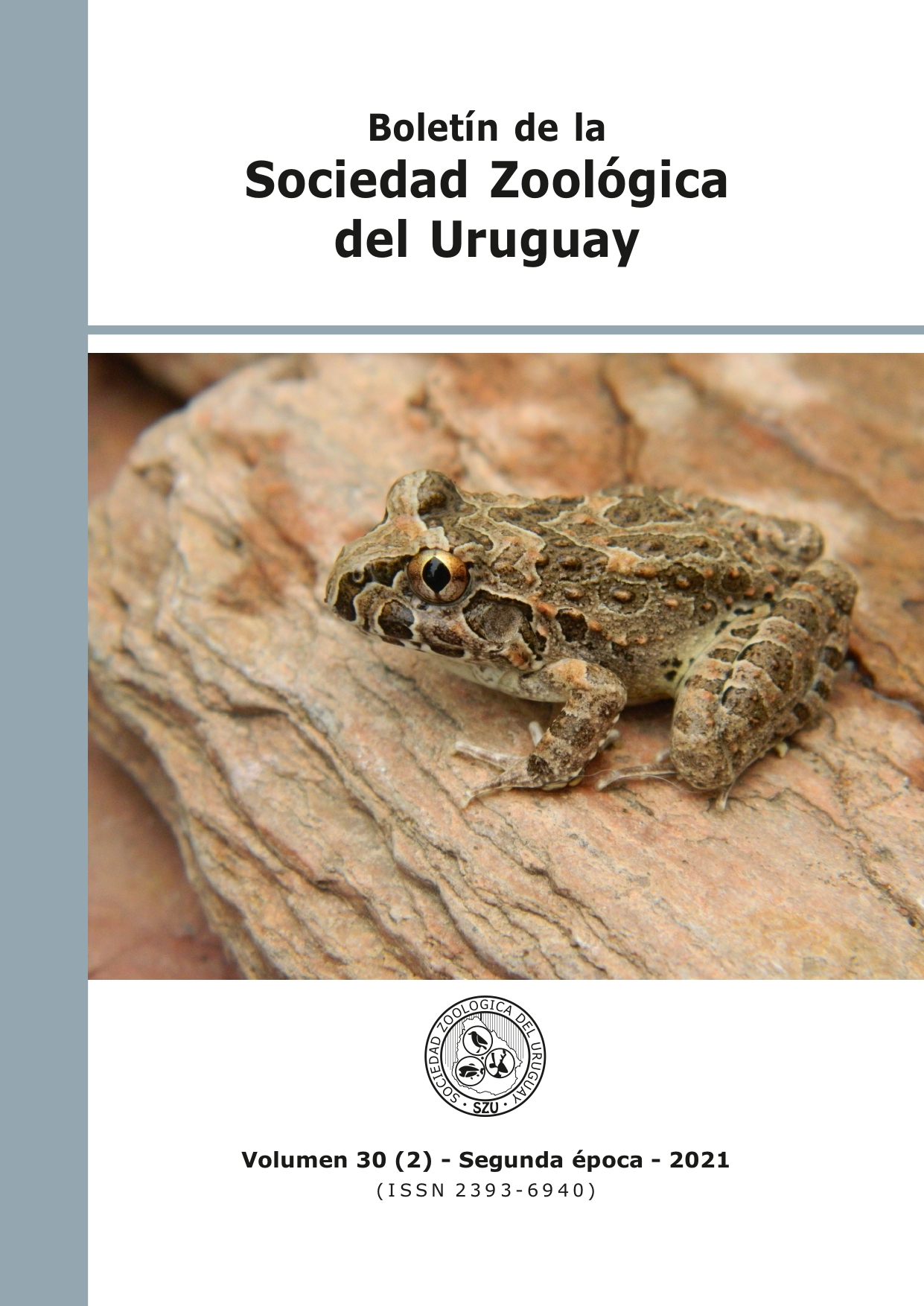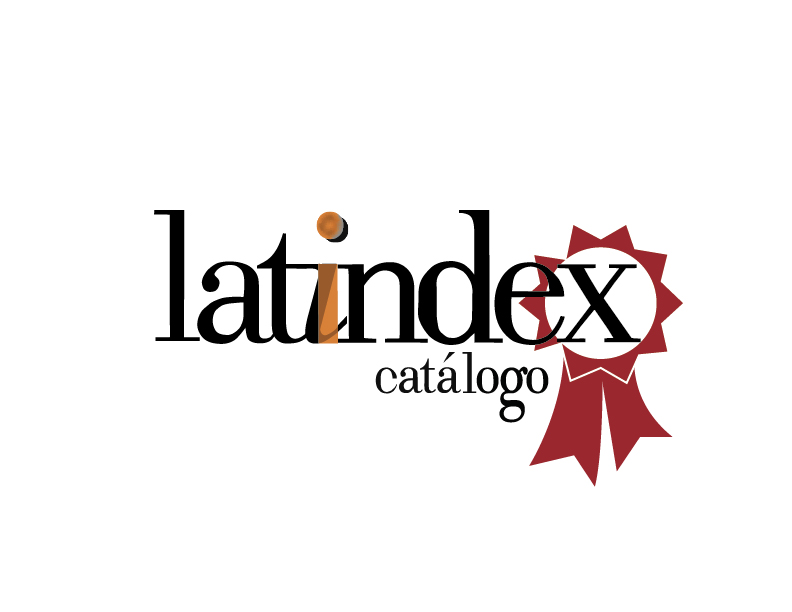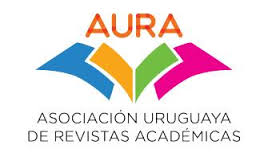POTENCIAL USO DE LOS MACROINVERTEBRADOS COMO INDICADORES DE LA CALIDAD DEL AGUA EN CUENCAS ALTAS DE BAJO IMPACTO: CASO DE LA CUENCA DEL ARROYO SAN FRANCISCO, URUGUAY
DOI:
https://doi.org/10.26462/30.2.8Palabras clave:
Bentos, %EPT, %OligochaetaResumen
Las comunidades de macroinvertebrados de arroyos están moduladas por diferentes procesos en diferentes escalas espaciales, desde la cuenca hasta los tramos a escala local, que pueden verse afectados directa o indirectamente por las actividades humanas y los cambios en el uso del suelo. Este estudio evaluó el efecto de la calidad del agua en la estructura de macroinvertebrados en la cuenca de drenaje San Francisco, Lavalleja, Uruguay. Medimos in situ variables fisicoquímicas del agua y recolectamos un total de 50 muestras de macroinvertebrados utilizando un surber en 10 tramos de arroyos con diferente orden y tamaño de cuenca. Las estructuras de macroinvertebrados se analizaron utilizando densidad, riqueza y dos índices bioindicadores comunes; porcentaje de número de Ephemeroptera, Plecoptera y Trichoptera (% EPT) y porcentaje de Oligochaeta (% Oligochaeta). No se encontró una relación significativa entre las variables fisicoquímicas del agua y el orden de los arroyos, pero los arroyos de bajo orden tenían una concentración de nutrientes y conductividad de agua comparativamente más alta. El orden de los arroyos mostró una relación positiva significativa con %EPT y una relación negativa con %Oligochaeta. No se encontraron patrones de densidad y riqueza taxonómica. Algunos componentes de la estructura de la comunidad de macroinvertebrados en los arroyos pertenecientes a la cuenca del arroyo San Francisco podrían explicarse en gran medida por la calidad del agua, en este caso relacionada con el orden de los arroyos. Encontramos evidencia del gran potencial uso de macroinvertebrados como indicadores de calidad ambiental, incluso en cuencas de drenaje bien conservadas.
Descargas
Citas
Allan, J.D. (2004). Landscapes and riverscapes: the influence of land use on stream ecosystems. Annual Review of Ecology, Evolution and Systematics, 35, 257–284.
Allan, J.D., y Castillo, M.M. (2007). An introduction to fluvial ecosystems. Stream Ecology: Structure and function of running waters, 1–12.
Allan, J.D., Castillo, M.M., y Capps, K.A. (2020). Stream ecology: structure and function of running waters. Springer Nature.
Altermatt, F. (2013). Diversity in riverine metacommunities: a network perspective. Aquatic Ecology, 47, 365–377. https://doi.org/10.1007/s10452-013-9450-3
Arocena, R. (1996). La comunidad bentónica como indicadora de zonas de degradación y recuperación en el Arroyo Toledo (Uruguay). Revista Biología Tropical, 44, 659–671.
Arocena, R. (1998). Statistical analysis of benthic communities to assess suspected degradation and recuperation zones in an urban stream (Uruguay). Verhandlungen der Internationalen Vereinigung fur Theoretische und Angewandte Limnologie, 26, 1188–1192.
Bonada, N., Prat, N., Resh, V.H., y Statzner, B. (2006). Developments in aquatic insect biomonitoring: a comparative analysis of recent approaches. Annual Review of Entomolog., 51, 495–523.
Brown, B.L., y Swan, C.M. (2010). Dendritic network structure constrains metacommunity properties in riverine ecosystems. Journal of Animal Ecology, 79(3), 571–580.
Burwood, M., Clemente, J., Meerhoff, M., Iglesias, C., Goyenola, G., Fosalba, C., ... y Teixeira de Mello, F. (2021). Macroinvertebrate communities and macrophyte decomposition could be affected by land use intensification in subtropical lowland streams. Limnetica, 40(2), 343–357.
Carpenter, S.R. (2008). Phosphorus control is critical to mitigating eutrophication. Proceedings of the National Academy of Sciences, 105(32), 11039–11040.
Chalar, G. (1994). Composición y abundancia del zoobentos del Arroyo Toledo (Uruguay) y su relación con la calidad del agua. Revista Chilena de Historia Natural, 67, 129–141.
Chalar, G., Arocena, R., Pacheco, J.P., y Fabián, D. (2011). Trophic assessment of streams in Uruguay: A Trophic State Index for Benthic Invertebrates (TSI-BI). Ecological Indicators, 11(2),362–369. https://doi.org/10.1016/j.ecolind.2010.06.004
Chang, F.H., Lawrence, J.E., Rios-Touma, B., y Resh, V.H. (2014). Tolerance values of benthic macroinvertebrates for stream biomonitoring: Assessment of assumptions underlying scoring systems worldwide. Environmental Monitoring and Assessment, 186(4), 2135–2149. https://doi.org/10.1007/s10661-013-3523-6
Chaves L.M., Chainho P.M., Costa J.L., Prat N. y Costa M.J. (2005). Regional and local environ- ments factors structuring undisturbed benthic macroinvertebrate communities in the Mondego River basin, Portugal. Archiv für Hydrobiologie, 163(4), 497–523. https://doi. org/10.1127/0003- 9136/2005/0163-0497.
Chung, N., Bae, M.J., Li, F., Kwon, Y.S., Kwon, T.S., Kim, J.S., y Park, Y.S. (2012). Habitat characteristics and trophic structure of benthic macroinvertebrates in a forested headwater stream. Journal of Asia-Pacific Entomology, 15(3), 495–505.
Collins, S.E., Matter, S.F., Buffam, I., y Flotemersch, J.E. (2018). A patchy continuum? Stream processes show varied responses to patch- and continuum-based analyses. Ecosphere, 9(11), e02481. https://doi.org/10.1002/ecs2.2481
Domínguez, E. y Fernández, H.R. (2009). Macroinvertebrados bentónicos sudamericanos. Sistemática y biología. 1a ed. Tucumán: Fundación Miguel Lillo. Argentina.
Doretto, A., Piano, E., y Larson, C.E. (2020). The river continuum concept: Lessons from the past and perspectives for the future. Canadian Journal of Fisheries and Aquatic Sciences, 77(11), 1856–1864. https://doi.org/10.1139/cjfas-2020-0039
Dormann, C.F., Elith, J., Bacher, S., Buchmann, C., Carl, G., Carré, G., ... y Lautenbach, S. (2013). Collinearity: a review of methods to deal with it and a simulation study evaluating their performance. Ecography, 36(1), 27–46.
Gazzano, I., Achkar, M., y Díaz Gazzano, I. (2019). Agricultural Transformations in the Southern Cone of Latin America: Agricultural Intensification and Decrease of the Aboveground Net Primary Production, Uruguay's Case. Sustainability, 11(24), 1–16.
Giri, S., y Qiu, Z. (2016). Understanding the relationship of land uses and water quality in Twenty First Century: A review. Journal of Environmental Management, 173, 41–48. https://doi.org/10.1016/j.jenvman.2016.02.029
Goyenola, G., Kruk, C., Mazzeo, N., Nario, A., Perdomo, C., Piccini, C., y Meerhoff, M. (2021). Producción, nutrientes, eutrofización y cianobacterias en Uruguay. INNOTEC, 22, e558-e558.
Hammer, Ø., Harper, D.A. y PRyan, P.D. (2001). PAST: paleontological statistics software package for education and data analy- sis. Palaeontologia Electronica, 4(1), 1–9.
Hentges, S.M., Menzel, T.C., Loebens, C.M., Siveris, S.E., Reynalte-Tataje, D.A., y Strieder, M.N. (2021). Structure of aquatic macroinvertebrate communities in streams of a sub-basin in the Pampa Biome, Southern Brazil. Neotropical Biology and Conservation, 16(2), 249–271. https://doi.org/10.3897/neotropical.16.e60579.
Humphries, P., Keckeis, H., y Finlayson, B. (2014). The river wave concept: Integrating river ecosystem models. BioScience, 64(10), 870–882. https://doi.org/10.1093/biosci/biu130
Hussain, Q.A. (2012). Macroinvertebrates in streams: A review of some ecological factors. International Journal of Fisheries and Aquaculture, 4(7), 114–123.
Hynes, H.B.N. (1975). The stream and its valley: With 4 figures and 2 tables in the text. Internationale Vereinigung für theoretische und angewandte Limnologie: Verhandlungen, 19(1), 1–15.
Jiang, X.M., Xiong, J., Qiu, J.W., Wu, J.M., Wang, J.W., y Xie, Z.C. (2010). Structure of macroinvertebrate communities in relation to environmental variables in a subtropical Asian river system. International Review of Hydrobiology, 95 (1), 42–57. https://doi.org/10.1002/iroh.200811131
Lamouroux, N., Dolédec, S., y Gayraud, S. (2004). Biological traits of stream macroinvertebrate communities: effects of microhabitat, reach, and basin filters. Journal of the North American Benthological Society, 23(3), 449-466.
Legendre, P., y Legendre, L. (1998). Numerical ecology, (Developments in Environmental Modelling, 20.
Maasri, A., Thorp, J.H., Kotlinski, N., Kiesel, J., Erdenee, B., y Jähnig, S.C. (2021). Variation in macroinvertebrate community structure of functional process zones along the river continuum: New elements for the interpretation of the river ecosystem synthesis. River Research and Applications, 37(4), 665–674. https://doi.org/10.1002/rra.3784
Mandaville, S. M. (2002). Benthic Macroinvertebrates in Freshwaters - Taxa Tolerance Values, Metrics, and Protocols. Soil y Water Conservation Society of Metro Halifax. Nova Scotia, Canada. Marchese, M.R. (2009). Annelida Oligochaeta. En: E. Domínguez y H.R. Fernández (eds.) Macroinvertebrados bentónicos sudamericanos: sistemática y biología (pp. 551–564). Fundación Miguel Lillo. Tucumán, Argentina.
Meerhoff, M., Bruzzone, C., Burwood, M., Clemente, J.M., Fosalba, C., Goyenola, G., ... y Teixeira de Mello, F. (2017). Diagnóstico Ambiental del Embalse Maggiolo y su cuenca. Arroyo San Francisco, Lavalleja. CURE-UDELAR.
Miserendino, M.L. (2009). Effects of flow regulation, basin characteristics and land-use on macroinvertebrate communities in a large arid Patagonian river. Biodiversity and Conservation, 18(7), 1921 - 1943. https://doi.org/10.1007/s10531-008-9565-3
Miserendino, M.L., y Pizzolon, L.A. (2003). Distribution of macroinvertebrate assemblages in the Azul- Quemquemtreu river basin, Patagonia, Argentina. New Zealand Journal of Marine and Freshwater Research, 37(3), 525–539. https://doi.org/10.1080/00288330.2003.9517187
Morelli, E., y Verdi, A. (2014). Diversidad de macroinvertebrados acuáticos en cursos de agua dulce con vegetación ribereña nativa de Uruguay. Revista Mexicana de Biodiversidad, 85(4), 1160–1170. https://doi.org/10.7550/rmb.45419
R Core Team. (2013). R: A language and environ- ment for statistical computing. R Foundation for Statistical Computing, Vienna, Austria.
Resh, V.H., y Rosenberg, D.M. (1993). Freshwater biomonitoring and benthic macroinvertebrates (No. 504.4 FRE). New York, NY, USA: Chapman y Hall.
Roldán, G. (1988). Guía para el estudio de los macroinvertebrados acuáticos del Departamento de Antioquia. Fondo FEN Colombia, Bogotá.
Sargac, J., Johnson, R.K., Burdon, F.J., Truchy, A., Rîşnoveanu, G., Goethals, P., y McKie, B.G. (2021). Forested Riparian Buffers Change the Taxonomic and Functional Composition of Stream Invertebrate Communities in Agricultural Catchments. Water, 13(8), 1028.
Schmitt, R., Lemes da Silva, A.L., de Macedo Soares, L.C.P., Petrucio, M.M., y Siegloch, A.E. (2020). Influence of microhabitat on diversity and distribution of Ephemeroptera, Plecoptera, and Trichoptera in subtropical forest streams. Studies on Neotropical Fauna and Environment, 55(2), 129–138. https://doi.org/10.1080/01650521.2019.1704984
Stendera, S., Adrian, R., Bonada, N., Cañedo-Argüelles, M., Hugueny, B., Januschke, K., ... Hering, D. (2012). Drivers and stressors of freshwater biodiversity patterns across different ecosystems and scales: a review. Hydrobiologia, 696(1), 1–28.
Strahler, A.N. (1957). Quantitative analysis of watershed geomorphology. Eos, Transactions American Geophysical Union, 38(6), 913–920.
Thorp, J.H., Thoms, M.C., y Delong, M.D. (2006). The riverine ecosystem synthesis: biocomplexity in river networks across space and time. River Research and Applications, 22(2), 123-147.
Valderrama, J.C. 1981. The simultaneous analysis of total nitrogen and total phosphorus in natural waters. Marine Chemistry, 10(2), 109–122. DOI: 10.1016/0304-4203(81) 90027-X
Vannote, R.L., Minshall, G.W., Cummins, K.W., Sedell, J.R., y Cushing, C.E. (1980). The river continuum concept. Canadian journal of fisheries and aquatic sciences, 37(1), 130–137.
Wang, X., Zhang, Y., Tan, X., Zheng, Y., y Zhang, Q. (2021). Do water quality, land use, or benthic diatoms drive macroinvertebrate functional feeding groups in a subtropical mountain stream? Inland Waters, 11(1), 67–77. doi.org/10.1080/20442041.2020.1816111
Winemiller, K.O., Flecker, A.S., y Hoeinghaus, D.J. (2010). Patch dynamics and environmental heterogeneity in lotic ecosystems. Journal of the North American Benthological Society, 29(1), 84–99.











